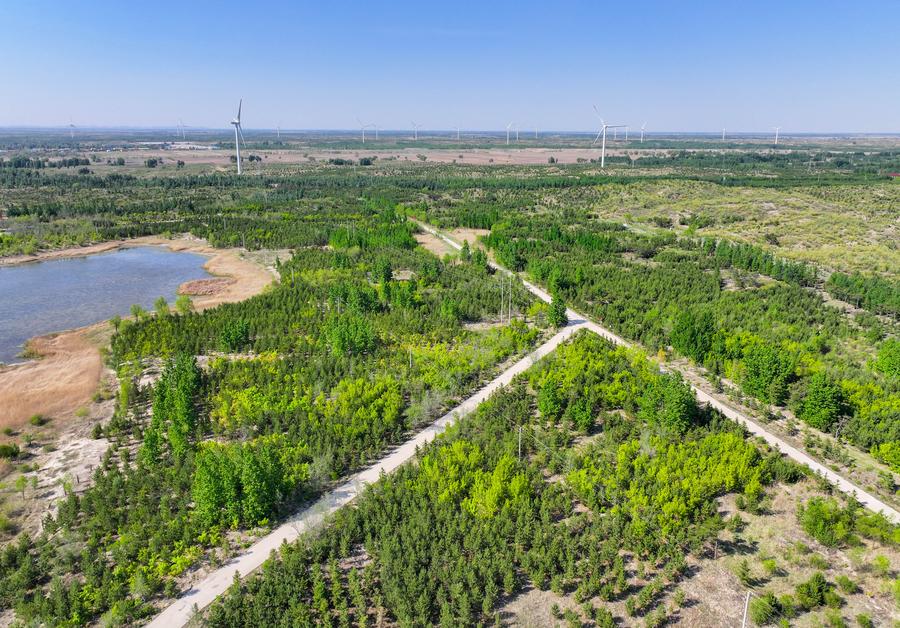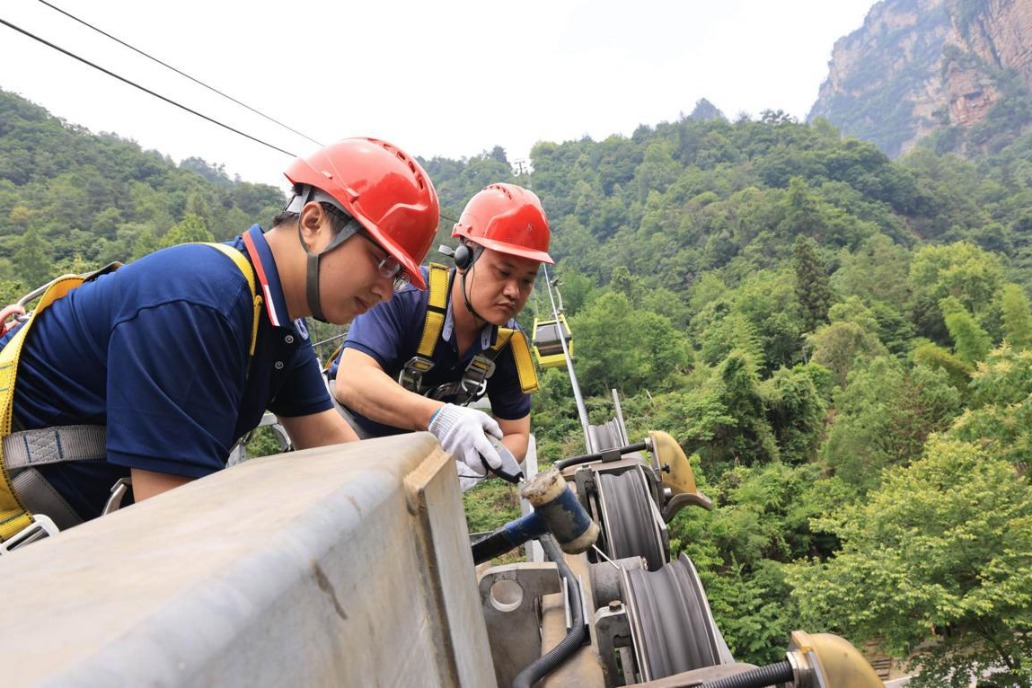Nation's resolve to remain firm in fighting desertification


Although considerable achievements have already been made in the fight against desertification, China's top forest and grassland management body has pledged to remain vigilant and committed to the global struggle with shifting sands.
"As a global model for desertification control, we will thoroughly implement President Xi Jinping's important initiative to improve global ecological governance and build an eco-friendly world economy, extensively engage in international exchanges and cooperation, implement the United Nations Convention to Combat Desertification, continue to contribute Chinese wisdom, and promote global environmental governance and protection," said Guan Zhi'ou, director of the National Forestry and Grassland Administration, in a recent interview with China Daily.
China's efforts in holding back its deserts date back more than 50 years, and the nation has achieved zero net growth in land degradation, as well as a reduction in desertification and sandy land, Guan said. China is willing to share its experience in combating desertification with other countries, the official added.
In 1978, China launched the Three-North Shelterbelt Forest Program, which has a planned duration of 73 years. China joined the United Nations Convention to Combat Desertification in 1994 as one of its first signatories.
In June last year, President Xi issued a call for action to tackle the critical challenges of the program and strive to create new miracles in desertification control in the new era. This marked a historic new phase in China's efforts to combat desertification.
Over the past 46 years, the forest coverage rate in the project area has increased from just over 5 percent to 13.84 percent, creating a vast green barrier in northern China, Guan said.
According to the administration, 53 percent of China's treatable desertified land has been managed. By the end of last year, the forest coverage rate exceeded 25 percent, with forest stock volume surpassing 20 billion cubic meters and annual carbon sequestration reaching more than 1.2 billion metric tons.
The Three-North Shelterbelt Forest Program has been recognized in the Global 500 Roll of Honour for Environmental Achievement by the United Nations Environment Programme. The UNCCD Secretariat has also twice honored China for its "outstanding contribution to combating desertification".
China now has the largest area of planted forests in the world and is the largest contributor to global greening, said Guan.
At the 13th session of the Conference of the Parties of the UNCCD, which was held in Ordos, Inner Mongolia autonomous region, in 2017, a global goal of achieving "land degradation neutrality" by 2030 was established. China has already met the target ahead of schedule.
"After more than half a century of continuous efforts, especially since the 18th National Congress of the Communist Party of China in 2012, under the guidance of Xi Jinping Thought on Ecological Civilization, our approach to combating desertification has become more scientific, with improved top-level design, more comprehensive working mechanisms and stronger policy support," Guan said.
Legislative endeavor
China launched the world's first law on sand control in 2002. Guan said the country has incorporated desertification control into its legal framework, including into laws such as the Law on Prevention and Control of Desertification, the Forest Law, the Grassland Law, the Wetland Protection Law, the Qinghai-Tibet Plateau Ecological Protection Law, and the Yellow River Protection Law. Thirteen key provincial-level regions affected by desertification have also enacted their own regulations or implemented measures for controlling desertification.
"Natural elements are interdependent and interconnected. In combating desertification, the Chinese government adheres to the philosophy that 'mountains, rivers, forests, farmlands, lakes, grasslands and deserts form a community of life'. This coordinated approach across various departments ensures comprehensive protection and restoration of ecosystems," Guan said.
Under the Three-North Shelterbelt Forest Program, people have developed various methods such as straw checkerboard barriers, aerial seeding and sandy land closure for revegetation, overcoming technical challenges in the restoration of forest and grass cover in arid and semiarid areas and significantly improving survival rates, he said.
In recent years, mechanized and intelligent technologies such as sand fixation machinery and drone seeding have been widely adopted.
"Currently, nearly half of the afforestation in the Three-North project is done mechanically. Science and technology has become a key tool in solving desertification challenges," Guan said.
China will accelerate the development of key technologies, scientifically allocate forest and grass vegetation, and conduct thorough surveys, monitoring and assessment of ecological protection and restoration efforts, he said.
Guan noted that during the process of sand control, China emphasizes economic effects at the same time.
"Various regions utilize unique resources in sandy areas to appropriately develop industries such as traditional Chinese medicinal herbs, high-quality forage grass, economic forests and fruits, and desert tourism, thereby aiding rural vitalization," he said.
Some regions like the Loess Plateau and the Xinjiang Uygur autonomous region have established a number of production bases for forest fruits, melons and woody oil plants, with an annual output of 48 million tons of dried and fresh fruit, accounting for 25 percent of the nation's total production. In key areas, income from forest fruits constitutes more than half of farmers' net income, he said.
According to the UN Convention to Combat Desertification's latest "Global Land Outlook" report, approximately 40 percent of the world's land is experiencing desertification and degradation, and land degradation and drought have directly affected 50 percent of the global population.
In October last year, the UNCCD Secretariat launched a Data Dashboard, compiling data from 126 countries and regions. This found that land degradation is occurring at an "alarming rate" worldwide. Between 2015 and 2019, the world on average lost at least 10 million hectares of healthy, productive land annually, with sub-Saharan Africa, West Asia, South Asia and the Latin America and Caribbean region experiencing higher than average rates of degradation.
President Xi has emphasized many times that desertification is a severe challenge faced by all of humanity.
Sharing experience
Guan said that sharing experiences with other countries has been essential to making progress.
"We have extensively engaged in international cooperation and promoted desertification control in countries involved in the Belt and Road Initiative," Guan said, adding that the Badain Jaran Desert Dunes and Lakes area in Inner Mongolia was listed as a UNESCO Natural World Heritage site in July, which is among the major achievements that China has made internationally in sand control and environmental protection.
On this front, China has established the China-Arab International Research Center on Drought, Desertification and Land Degradation in Beijing with the Arab League, and the China-Mongolia Desertification Prevention and Control Cooperation Center in Ulan Bator, the capital of Mongolia.
It has also set up demonstration bases for desertification control in Mongolia, Central Asia and Africa, providing technical support and data products for initiatives such as the Great Green Wall in Africa and Mongolia's One Billion Trees campaign.
"China will focus on strengthening cooperation with neighboring countries, supporting desertification control in countries involved in the Belt and Road Initiative, and leading policy dialogues and information sharing to jointly tackle sandstorm disasters," Guan said.
He added that the administration has been preparing and organizing activities for the China Pavilion at the upcoming 16th session of the Conference of the Parties of the UNCCD, which will be held in Riyadh, Saudi Arabia, from Dec 2 to 13. At the conference, it will share experiences from the Three-North project and other desertification control efforts.
yandongjie@chinadaily.com.cn






































